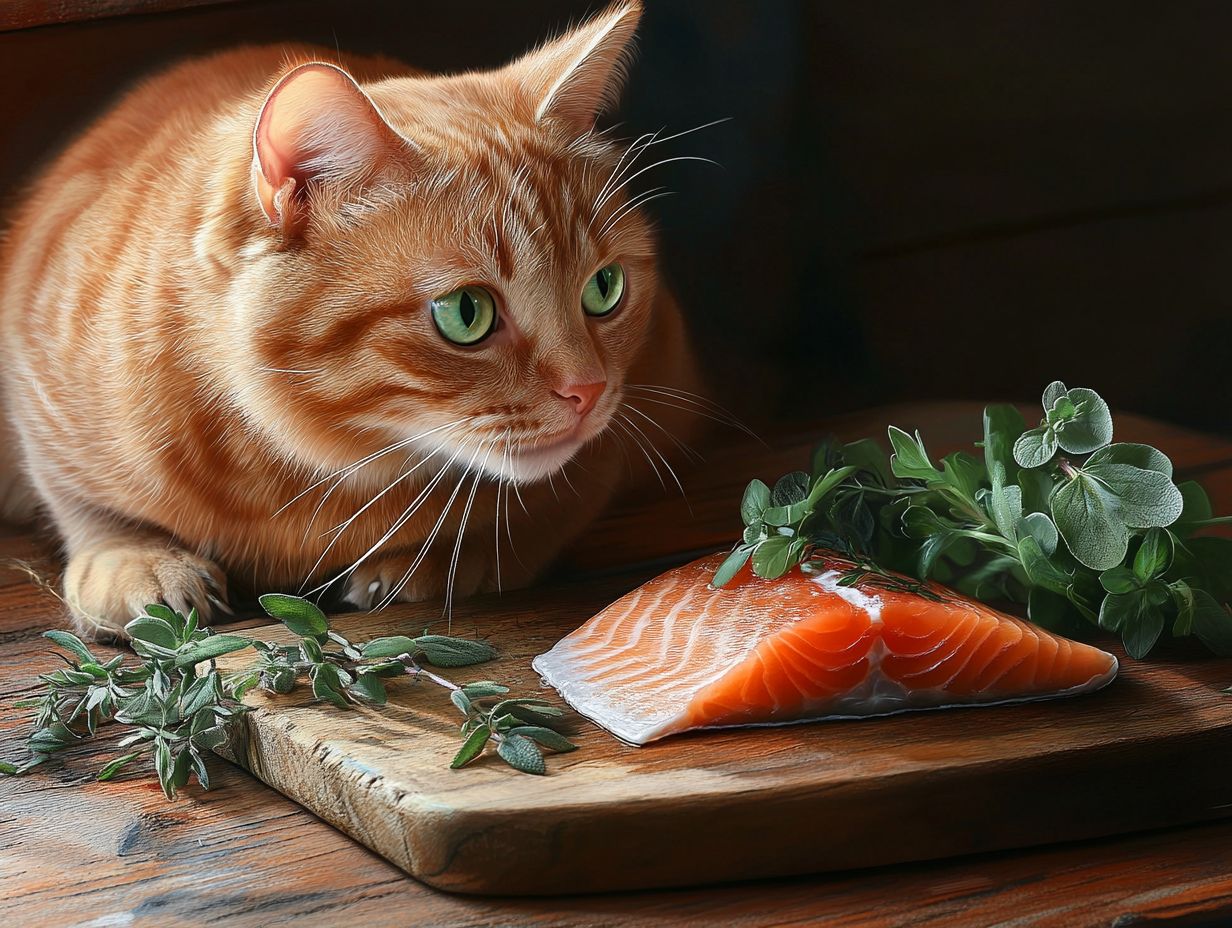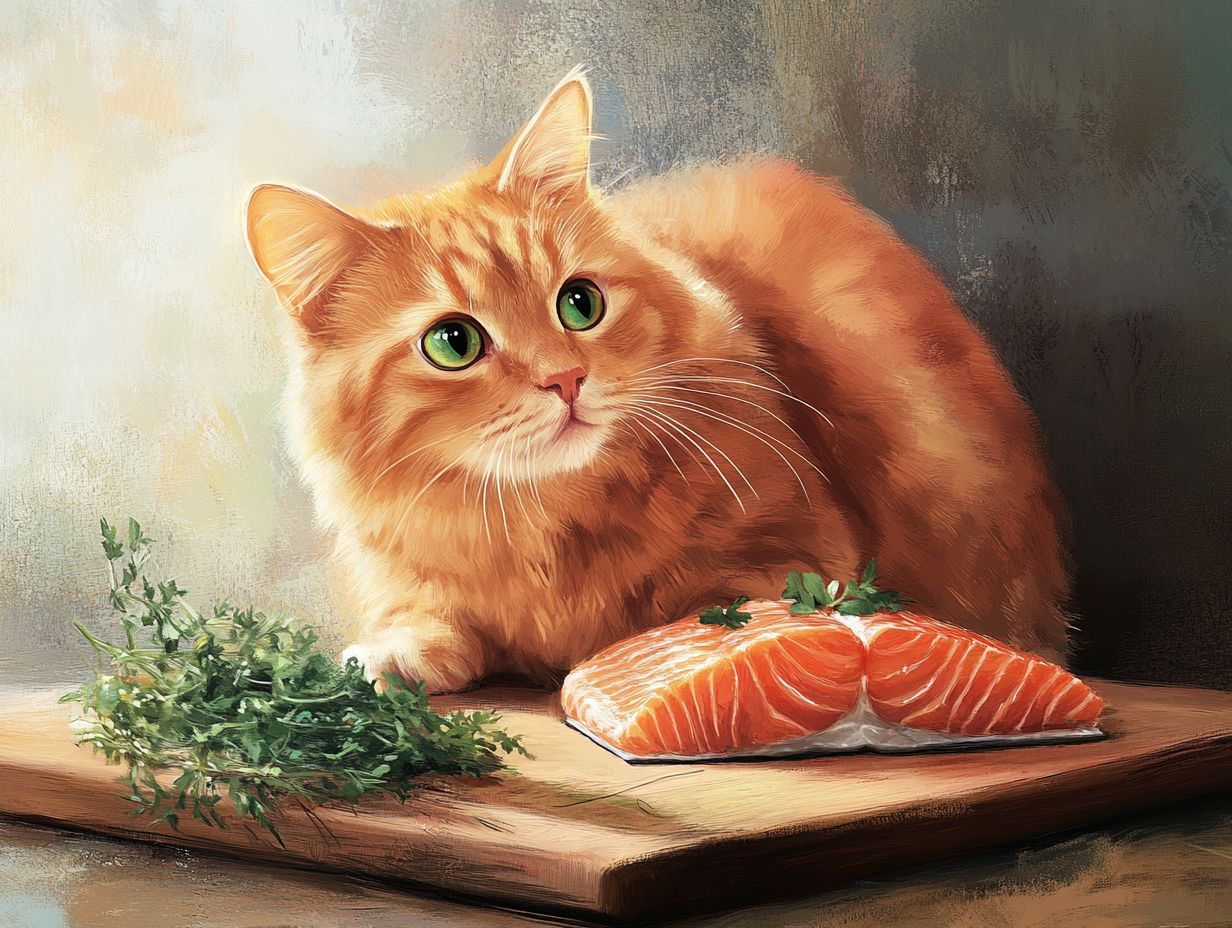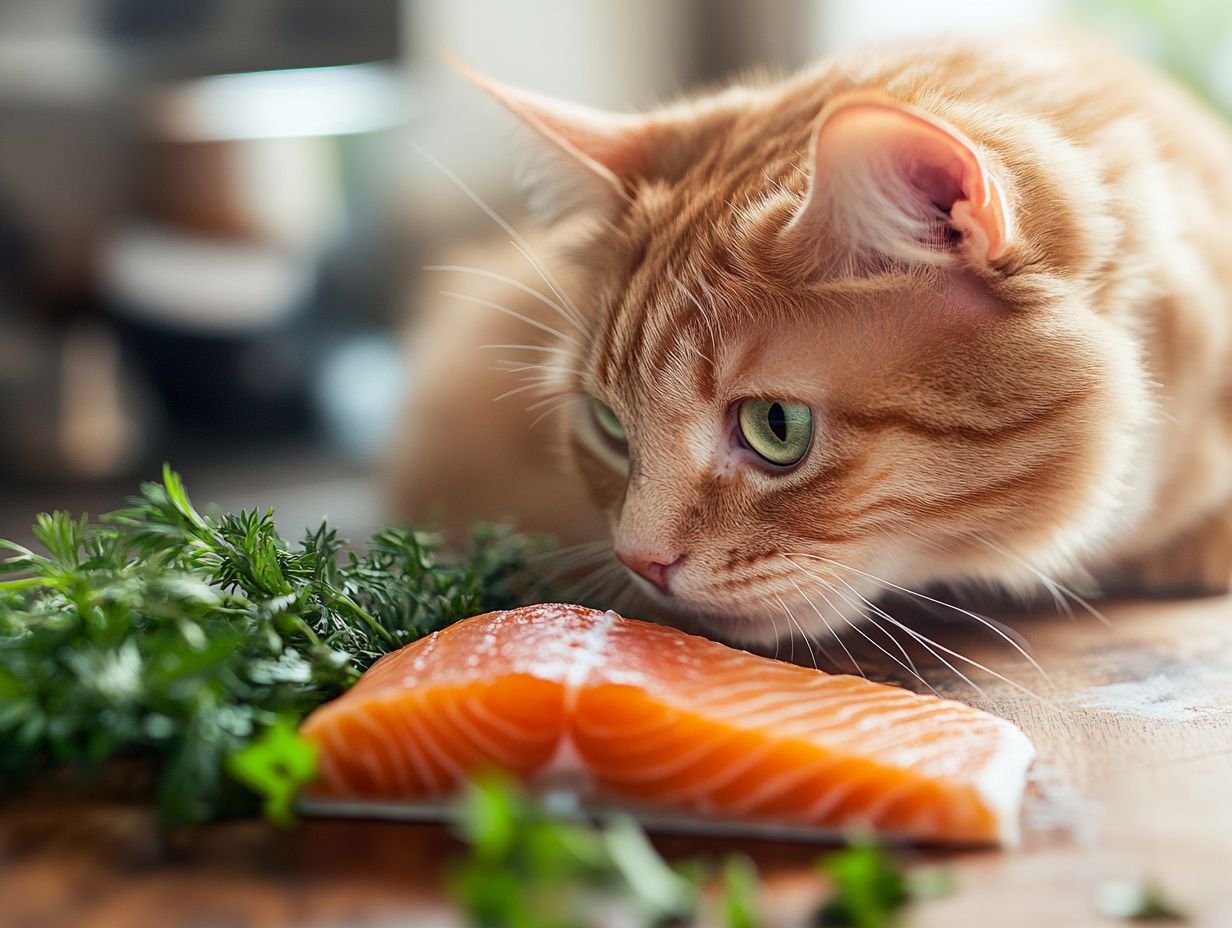Curious about feeding your feline friend raw salmon? While it may seem like a delicious treat, raw salmon can pose risks if not handled properly. In this article, we will explore whether raw salmon is safe for cats, how to properly prepare and store it, and some tasty alternatives, including cooked fish and other nutritious foods. We will also identify signs of salmon poisoning and discuss how to treat symptoms, such as diarrhea and vomiting, should they arise.
Learn the ins and outs of keeping your cat healthy and happy, including tips on maintaining a balanced diet rich in essential nutrients!
Key Takeaways:

- Raw salmon can potentially provide health benefits for cats, such as improved skin and coat health, but it also comes with risks, including parasites and bacteria.
- Proper handling and storage of raw salmon are crucial to reduce the risk of salmon poisoning in cats from harmful parasites.
- If you are concerned about the health risks of feeding your cat raw salmon, there are plenty of safe and nutritious alternatives, such as cooked fish and specially formulated feline treats.
Is Raw Salmon Safe for Cats?
The safety of raw salmon for cats depends on several factors, including the nutritional components of the salmon, potential health hazards associated with it, and your cat’s specific health condition.
As meat-eaters, cats require high levels of protein, and nutrients found in salmon, such as omega-3 fatty acids, can offer health benefits and enhance their skin and coat health.
Potential Health Benefits
Feeding cats salmon can offer several health benefits, including enhanced overall health and improved skin and coat condition, thanks to the fish’s high concentration of omega-3 fatty acids, protein, and essential vitamins.
The omega-3 fatty acids in salmon contribute to better heart health, help reduce inflammation, and support eye health and brain function.
Additionally, the high protein content of salmon supports muscle development and repair, aids in weight management, and boosts energy levels. Essential vitamins, such as B12, Vitamin A, and Vitamin D, play crucial roles in maintaining a healthy immune system, allowing cats to combat infections and diseases.
Potential Health Risks
While salmon can be beneficial for cats, there are potential health risks associated with its consumption, especially when it is raw. These risks include exposure to bacteria such as E. coli and Salmonella, as well as various parasites, all of which can adversely affect your cat’s health.
Contaminants can lead to diarrhea and other gastrointestinal issues, ranging from mild digestive upset to life-threatening infections that may require veterinary intervention. Parasites like tapeworms and roundworms can also be transmitted through raw fish, posing serious health risks to your cat.
Practical Tips for Safe Feeding of Salmon
- Purchase salmon from reputable suppliers such as the Alaskan Salmon Company.
- Consider cooking the fish to eliminate any harmful organisms.
- If feeding raw salmon, ensure it is specifically labeled as safe for pet consumption.
- Consult a veterinarian to determine appropriate feeding practices that meet your cat’s dietary needs.
- Portion size for raw salmon should not exceed one tablespoon as an occasional treat.
- For cooked salmon, offer 1-2 tablespoons without bones or seasoning.
How to Prepare Raw Salmon for Cats

Raw salmon must be handled and stored carefully to ensure both safety and quality. It is advisable to purchase high-quality salmon, such as that offered by the Alaskan Salmon Company.
Understanding the proper methods for preparing, serving, and storing this nutritious food for your cat is essential for providing a well-rounded diet.
Signs of Salmon Poisoning
Be aware of the following signs of salmon poisoning: vomiting, diarrhea, lethargy, and loss of appetite. If you observe any of these symptoms, seek veterinary attention immediately.
Conclusion
While raw salmon can offer certain health benefits, it is important to be aware of the potential risks. Consider safe alternatives to raw salmon, such as cooked fish or specially formulated feline treats, to maintain a balanced and nutritious diet for your beloved cat. Always consult your veterinarian for personalized dietary advice.
Store raw salmon at temperatures below 40°F (4°C) and consume it within two days of purchase. If you do not plan to use it within that timeframe, freeze the fish at 0°F (-18°C) for at least seven days to eliminate any harmful parasites.
Always wash your hands and any surfaces that have come into contact with the raw fish to avoid cross-contamination. Using separate cutting boards and utensils for raw salmon can further prevent bacteria from spreading to other foods.
Alternatives to Raw Salmon for Cats
Healthy alternatives to raw salmon for cats include cooked fish and commercial cat food. If raw salmon is considered unsuitable for a cat—whether due to health concerns or personal preference—these options can still offer nutritious benefits.
Other Safe and Nutritious Foods
Along with raw salmon, there are many other safe and healthy foods for cats, such as cooked fish and specially formulated cat treats. These options promote a nutritious diet and help maintain a healthy weight, ensuring a balanced intake of calcium, magnesium, and other nutrients.
Cooked chicken, for instance, is an excellent source of protein that supports muscle maintenance. Vegetables like carrots and pumpkin offer fiber, which aids digestion and helps prevent hairballs. Include these in moderation to ensure a healthy balance in your cat’s diet.
Small amounts of berries and green leafy vegetables can also provide antioxidants and essential nutrients that boost immune function. Balance these foods with commercial cat food to ensure your cat receives all necessary vitamins and minerals while avoiding overindulgence in treats.
Frequently Asked Questions
Can Cats Eat Raw Salmon?

Cats can eat raw salmon, but it is not recommended. Raw salmon may contain bacteria and parasites that can be harmful to your cat’s health.
What are the safety risks of feeding my cat raw salmon?
The main safety risk of feeding your cat raw salmon is the potential for bacterial or parasitic infections, which can lead to various health issues and can even be fatal in some cases.
Are there any health benefits to feeding my cat raw salmon?
While raw salmon may be a source of protein and omega-3 fatty acids, the potential health risks outweigh any potential benefits. It is best to stick to cooked salmon or other safe sources of protein for your cat.
What should I do if my cat has eaten raw salmon?
If your cat has eaten raw salmon, monitor them closely for any signs of illness. Contact your veterinarian if you notice any vomiting, diarrhea, or other concerning symptoms, such as eye irritation or unusual lethargy.
Can cooked salmon be fed to cats, and is it recommended?
Yes, cooked salmon can be fed to cats as long as it is boneless and free from any seasoning or additives. It provides beneficial nutrients like Omega-3, Vitamins, and Protein. A small portion of cooked salmon (1-2 tablespoons) can be a healthy treat. Always remove bones before serving and limit fish treats to once a week.
Safe Alternatives to Raw Salmon
Yes, there are plenty of safe and healthy alternatives to feeding your cat raw salmon. Consider smoked salmon, which some cats enjoy, or explore options like cooked salmon, other types of fish, and high-quality commercial cat food specifically formulated for feline dietary needs.
Are there any precautions for introducing new foods to my cat?
When introducing new foods like salmon or other fish, do so gradually to monitor for any allergic reactions. Always consult your veterinarian before making significant changes to your cat’s diet.
In summary, while raw salmon poses risks, cooked salmon can be a healthy treat in moderation. Always consult your veterinarian for personalized dietary advice.